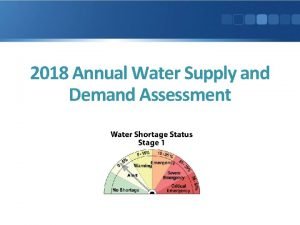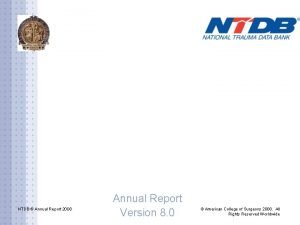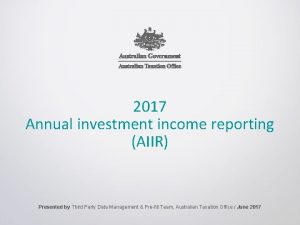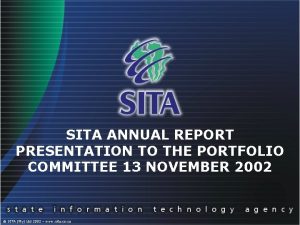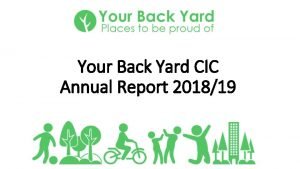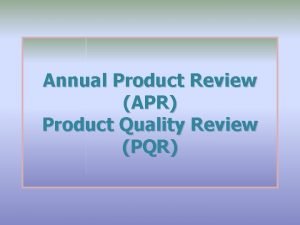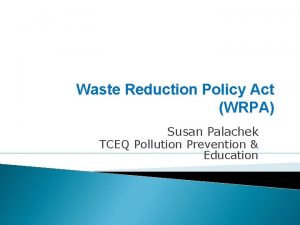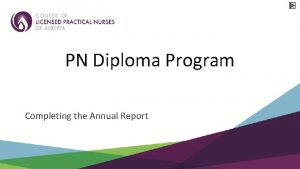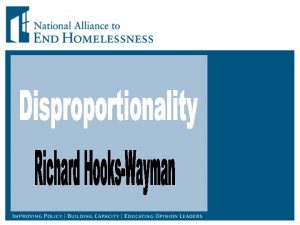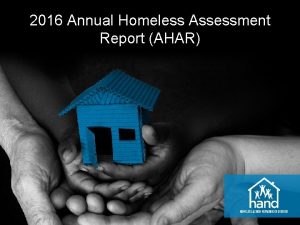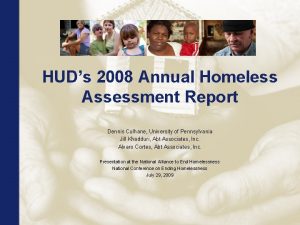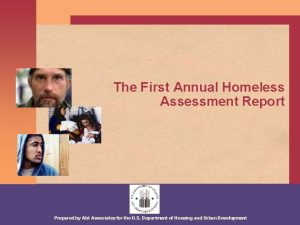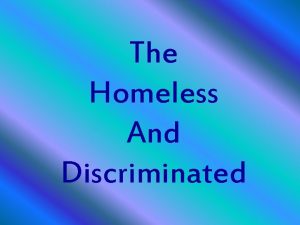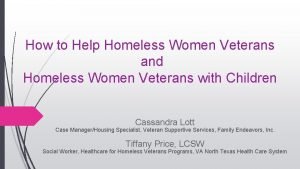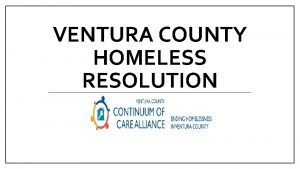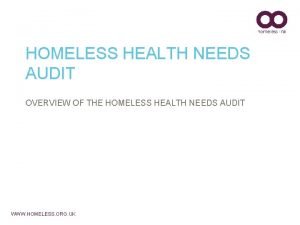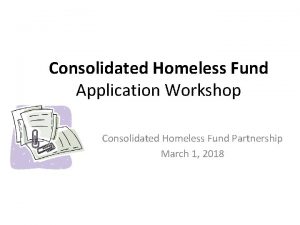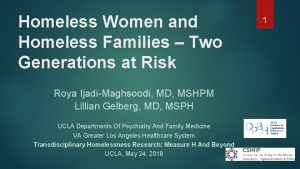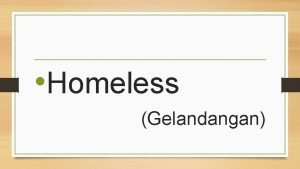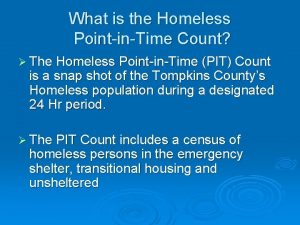The 2007 Annual Homeless Assessment Report A Report
















- Slides: 16

The 2007 Annual Homeless Assessment Report: A Report to Congress on Homelessness in America Paul Dornan, Office of PD&R, HUD Jill Khadduri, Abt Associates Inc. 2008 HMIS Training: Setting the September 22, 2008 Standard - U. S. Department of

The AHAR Report in Brief • National estimates based on a sample of data from the Homeless Management Information System (HMIS) – sheltered homeless people and their use of emergency shelter and transitional housing • Supplementary national estimates from 2007 Continuum of Care applications – sheltered and unsheltered homeless people 2 2008 HMIS Training: Setting the Standard - U. S. Department of Housing and Urban Development

What’s Special about this AHAR? • First report based on an entire year of data to provide national estimates of numbers of homeless people and their characteristics • Baseline for year to year comparisons • New information about long-term shelter users • Community-level information on the number of homeless persons 3 2008 HMIS Training: Setting the Standard - U. S. Department of Housing and Urban Development

Defining Homelessness • Literally homeless: shelters, transitional housing, or street • The AHAR report provides estimates of people who are literally homeless—the definition used for HUD Mc. Kinney-Vento programs 4 2008 HMIS Training: Setting the Standard - U. S. Department of Housing and Urban Development

HMIS Data Used for AHAR Estimates • 98 jurisdictions: 61 sample sites plus 37 contributing sites • One year period: October 2006 -September 2007 • Records for 284, 000 people (counting each person once) • Aggregate data was provided by AHAR jurisdictions in predefined tables and then analyzed by the study team 5 2008 HMIS Training: Setting the Standard - U. S. Department of Housing and Urban Development

Sheltered Homeless Persons: October 2006 to September 2007 • 1, 589, 000 people are living in emergency shelter or transitional housing during the study period • 70% are alone; 30% in families • 77% are in principal cities • 13% of homeless adults are veterans 6 2008 HMIS Training: Setting the Standard - U. S. Department of Housing and Urban Development

Sheltered Homeless Individuals • 1, 115, 000 people are homeless alone • 69% are adult men • 55% are between 32 and 50; only 4% are over age 62 • 57% are minority; 33% are African American • 40% are disabled 7 2008 HMIS Training: Setting the Standard - U. S. Department of Housing and Urban Development

Prior Housing of Sheltered Homeless Individuals Living Situation of Sheltered Individuals Not Homeless before Program Entry Sources: Homeless Management Information System data, October 2006–September 2007. 8 • 43% were already homeless (came from another shelter or the streets) • For those who did not come from shelter or the streets, many were staying with family/friends and in institutional settings 2008 HMIS Training: Setting the Standard - U. S. Department of Housing and Urban Development

Use of Residential Services by Sheltered Homeless Individuals Emergency Shelter • 82% used emergency shelter only • 40% stay a week or less; 70% stay no more than 1 month • Long-term users (in shelter 6+ months) are more likely to be African American and over age 50 Transitional Housing • 12% used transitional housing only; 6% used both TH & ES • Length of stay is longer than for emergency housing – about three months 9 2008 HMIS Training: Setting the Standard - U. S. Department of Housing and Urban Development

Sheltered Homeless Families with Children • 474, 000 homeless people – adults and children – in 131, 000 households during the study year • Typical family is a mother and 2 children • More than half of homeless children are under age 6 • 55% of sheltered homeless family members are African American 10 2008 HMIS Training: Setting the Standard - U. S. Department of Housing and Urban Development

Prior Housing of Sheltered Homeless Families with Children Living Situation of Sheltered Persons in Families Not Homeless Before Program Entry • 4% came from the streets; 27% came from another shelter • For those who did not come from shelter or the streets, the majority were staying with family/friends Source: Homeless Management Information System data, October 2006–September 2007. 11 2008 HMIS Training: Setting the Standard - U. S. Department of Housing and Urban Development

Use of Residential Services by Sheltered Homeless Families with Children Emergency Shelter • 69% used emergency housing only • 23% stay a week or less • But typical length of stay is 30 days (longer than for individuals) Transitional Housing • 31% spent some time in transitional housing during the year • Typical length of stay is 151 days 12 2008 HMIS Training: Setting the Standard - U. S. Department of Housing and Urban Development

2007 Point in Time Estimate: Sheltered and Unsheltered Homeless • Data submitted via annual Co. C funding applications • Communities estimated people in shelter and on streets, in abandoned buildings, or in other places not meant for human habitation • Almost certainly an overestimate because some communities included precariously housed people 13 2008 HMIS Training: Setting the Standard - U. S. Department of Housing and Urban Development

2006 -2007 Point-in-Time Counts Point-in-Time Count of Homeless Individuals and Persons in Families, January 2007 60% 63% 40% 37% Source: 2006 and 2007 Continuum of Care Application: Exhibit 1, Co. C Pont-in-Time Homeless Population and Subpopulations Charts. 14 2008 HMIS Training: Setting the Standard - U. S. Department of Housing and Urban Development

Chronically Homeless Persons • 124, 000 persons were chronically homeless on a night in January 2007 (18% of all homeless persons). Point in Time Count of Chronically Homeless Persons Source: 2007 Continuum of Care Application: Exhibit 1, Co. C Point-in-Time Homeless Population and Subpopulations Chart. 15 2008 HMIS Training: Setting the Standard - U. S. Department of Housing and Urban Development

Highlights of the 2007 AHAR • The number of homeless persons on a single night has dropped, including the number of chronically homeless. • For most, homelessness is short-term. • Homelessness is largely an urban phenomenon. • People who are long-term stayers are older and more likely to be disabled. • 474, 000 persons in families are homeless; younger families with pre-school children are at greatest risk. • Slight uptick in the number of homeless people who became homeless because of eviction/foreclosure. 16 2008 HMIS Training: Setting the Standard - U. S. Department of Housing and Urban Development
 Annual water supply and demand assessment
Annual water supply and demand assessment National trauma data bank annual report 2020
National trauma data bank annual report 2020 Compal electronics inc annual report
Compal electronics inc annual report Aiir reporting specifications
Aiir reporting specifications Sita annual report
Sita annual report Sen annual review report example
Sen annual review report example Cic annual report 2019
Cic annual report 2019 Kantar annual report
Kantar annual report Electranet annual report
Electranet annual report Annual product report
Annual product report Tceq p2 annual progress report
Tceq p2 annual progress report Sma annual report
Sma annual report Quiksilver
Quiksilver Diploma annual report
Diploma annual report Ian beckman
Ian beckman Annual status of education report
Annual status of education report Irlebird
Irlebird
